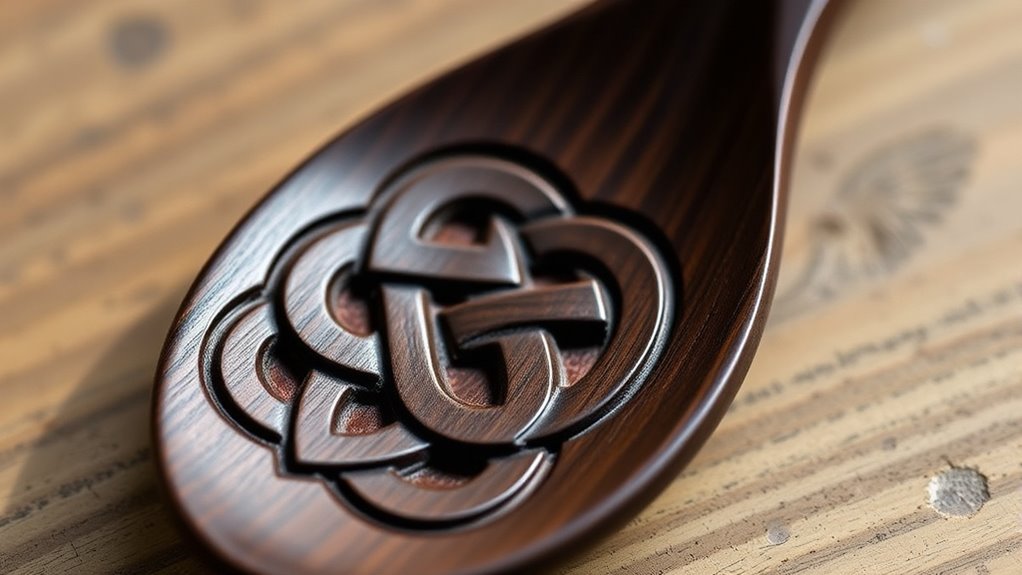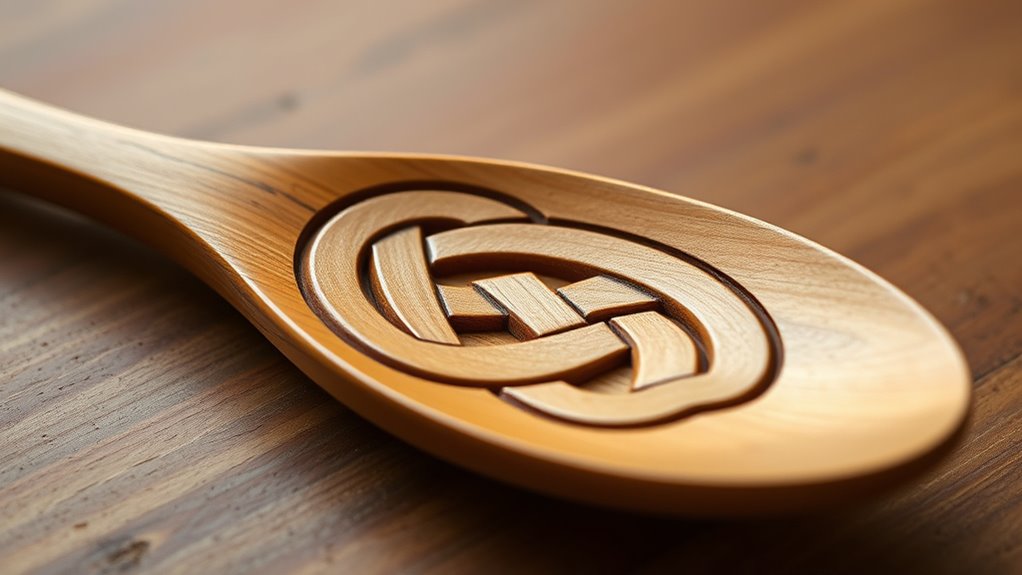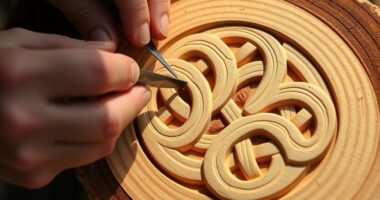To carve an elegant Celtic knot spoon by hand, start with choosing a durable wood like cherry or maple. Lightly sketch your design onto the wood, focusing on symmetry and flowing interwoven patterns. Use small carving knives and gouges to carefully carve out the knot, maintaining smooth, consistent curves and depth. Properly conditioning the wood and patience during carving help achieve a refined look. Keep practicing, and discover how to bring this intricate symbol to life step by step.
Key Takeaways
- Select a fine-grain, durable wood like cherry or maple and prepare it with light sanding or sealing.
- Sketch the Celtic knot design lightly onto the wood, focusing on symmetry and flow.
- Use hand carving tools such as gouges and knives to carefully carve out the interwoven knot pattern.
- Maintain consistent depth and smooth curves to ensure seamless, elegant interlacing of the knot.
- Finish with fine sanding and polishing to enhance detail and create a polished, beautiful Celtic knot spoon.

Have you ever wondered about the history behind the intricate designs on Celtic knot spoons? These patterns aren’t just decorative—they hold centuries of symbolism and tradition, making your carving project feel even more meaningful. When you begin, it’s essential to consider your design inspiration carefully. Celtic knots are characterized by endless loops and interwoven patterns that symbolize eternity and interconnectedness. You might draw inspiration from ancient artifacts, illuminated manuscripts, or modern interpretations that emphasize symmetry and flow. Once you’ve settled on a design, it’s time to think about material selection. The right wood can make a significant difference, so choose something durable yet workable, like cherry, maple, or walnut. These woods have fine grains that hold detail well, allowing you to carve intricate patterns with precision. Understanding the symbolic meaning behind Celtic knots can deepen your appreciation and connection to the design as you craft your spoon.
Starting your project, you’ll want to sketch your design directly onto the wood. Keep your lines light at first, so you can adjust as needed. Carving a Celtic knot spoon requires patience and a steady hand, but it’s entirely doable without CNC machines. Use simple hand tools like carving knives, gouges, and fine files to bring your design to life. Your choice of tools should correspond to the detail level of your pattern; finer tools allow for delicate interweaving, while broader chisels help shape the spoon’s overall form. As you carve, focus on maintaining consistent depth and smooth curves, ensuring the knots appear seamless and flowing.
Throughout the process, your material selection plays a vital role in the finished piece. A well-chosen wood not only enhances the aesthetic but also makes carving easier and more enjoyable. Before you start carving, consider conditioning your wood with a light sanding or a sealant, especially if it’s rough or porous. This step helps achieve cleaner lines and reduces the risk of splintering. As you work into the finer details of the Celtic knot, your material’s grain and quality will influence how crisp and precise your design appears.
Ultimately, carving your own Celtic knot spoon combines creativity with craftsmanship. Your design inspiration guides the artistic aspect, while careful material selection ensures your project’s success. With patience and attention to detail, you’ll craft a beautiful, meaningful piece that reflects both tradition and your personal touch—all without the need for high-tech tools.
Frequently Asked Questions
What Types of Wood Are Best for Carving Celtic Knot Spoons?
When choosing wood for your Celtic knot spoon, consider the wood selection carefully. Hardwoods like maple, cherry, or walnut work best because they hold detail well and are durable. Softwoods like basswood or cedar are easier to carve, making them good for beginners. Focus on your carving techniques to bring out intricate knots. With the right wood and skills, you’ll create a beautiful, lasting piece that showcases your craftsmanship.
How Long Does It Typically Take to Complete a Celtic Knot Spoon?
The time commitment to carve a Celtic knot spoon varies based on your skill level and the complexity of the design. If you’re a beginner, it might take several hours or even a weekend to complete. For more experienced woodworkers, it could be finished in a few hours. Keep in mind, patience and attention to detail are key to achieving an elegant result, so don’t rush the process.
Are There Any Safety Tips for Hand Carving Intricate Designs?
Safety starts with securing sharp tools, staying sharp, and skillfully slicing with caution. Proper lighting illuminates intricate details, preventing slips and mishaps. Maintain a steady hand, work patiently, and focus fully on each cut to prevent accidents. Wearing protective gear, like gloves and safety glasses, protects your hands and eyes. Remember, patience and preparation pave the path to beautifully carved, safe, and satisfying results on your Celtic knot spoon.
Can Beginners Successfully Carve Celtic Knot Spoons Without Prior Experience?
As a beginner, you can successfully carve Celtic knot spoons despite their design complexity. Focus on beginner techniques like marking your design clearly and using sharp tools. Take your time, start with simple patterns, and practice basic carving skills. Patience and attention to detail will help you improve. Remember, even intricate designs become easier as you gain experience, so don’t get discouraged if it takes a few tries.
What Tools Are Essential for Carving a Celtic Knot Spoon by Hand?
Think of hand carving as dancing with your tools. You’ll need a sharp carving knife and small gouges for detailed work, along with a fine rasp for shaping. Sandpaper smooths the surface, and a sharpening stone keeps your tools in top shape. Remember, good tool maintenance is key to precise cuts. With patience and the right tools, you’ll craft a beautiful Celtic knot spoon that sings with craftsmanship.
Conclusion
So, now you’re equipped to carve your own Celtic knot spoon—no fancy CNC needed. Who knew that a simple block of wood and a little patience could turn you into a master artisan? Just imagine the envy when friends see your “handcrafted” masterpiece, wondering if you secretly borrowed ancient Celtic magic. Go ahead, impress everyone with your “artisan skills”—just don’t forget to tell them you didn’t need any high-tech tools to make it happen.







